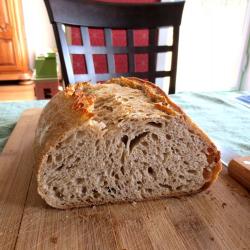
Hi! I have experimented a bit since my last posts, sometimes with limited success, varying baking temperatures and techniques. My worst bread was last week’s 100% white flour, mostly because I forgot to reduce heat in the oven, and then removed the water bowl too early. It wasn’t burnt (hopefully) but was very elastic with a hard crust and dull taste. I’ve also experimented with various mixes of whole wheat, white flour, kamut and spelt. I love spelt. It gives a velvety touch to the mie (inside of the loaf) and even though it doesn’t rise as much as wheat, the delicate nutty taste and texture make it a perfect bread for sandwiches or a quick snack.
STARTER: a random mix of whole wheat and white flour, 100% hydration
SPONGE
- 80g starter (refreshed in the morning)
- 100g whole wheat flour
- 100g water
DOUGH
- 180g starter (after a 5 to 6 hours rise)
- 150g organic spelt flour
- 250g organic white flour
- 215g bottled water
- 10g salt
Late in the morning, I refresh my starter. Then at 3pm I mix the sponge and let it sit on the counter, covered, until 18h30. It has doubled volume and is ready to use.
I then mix the dough, without the salt, and form a ball. I cover it and let it sit on the counter for 30 minutes (autolysis).
I start kneading it, slowly incorporating the salt. Spelt flour is NOT easy to knead by hand because after you add the salt it forms thin layers of dough, which tear easily as you push and fold. After 8 minutes kneading, the dough had developed the "elastic" qualities and the salt was fully incorporated.
I put the dough ball in a large, lightly oiled glass bowl covered with a damp cloth, and "flatten & fold" every hour, each time more delicately so that I don’t break the bubbles forming in the dough.
After 4 hours I flatten the dough slightly, then roll it like a cigar and store it in the fridge in a sealed bag (overnight).
Next morning at 7am, I get the dough out of the fridge and pre-heat the oven to 500°F for 45 minutes with a pizza stone at the 2nd rack (from the bottom). I add a bowl of water and keep pre-heating for 15 more minutes.
I then delicately install the bread on a lightly floured cutting board, and slash the bread. I immediately slide it onto the pizza stone, reduce the heat to 475°F and bake for 20 minutes, spraying some water now and then.
I remove the bowl of water, reduce the heat to 450°F and cook for 10 minutes more. I then slightly open the oven door to let the steam out, and block the door with a wooden spoon, and bake for another 5 minutes. Total baking time 35 minutes.
I get a good grigne and nice oven spring (yielding a very horizontal loaf), although it’s never as impressive as with my whole wheat/white flour bread.

Replies
Hi Hugo,
Your Spelt/Wheat loaf looks terrific. I may well have a go at your recipe. As I said previously I am new to all this and seem to have a thousand questions !! My sourdour loaves in the last couple of days have been wonderful and I feel inspired to progress and learn more. If you have the time perhaps you could answer a couple of questions for me. Firstly, what is the benefit of using a "Sponge" prior to making the dough ?? Secondly, when you prove the bread in the fridge are you concerned if the plastic bag rests on the dough whilst it is proving ? or do you create some kind of "tent" to keep the plastic bag from resting on the dough ?? I have only produced sourdough loaves shaped in a Banetton so I am a bit anxious about trying to creat other shapes and then transfer them from a platic bag into the oven. Cheers Chris
Hi Chris,
My guilty secret is that i use the plastic bread bags from the "pick & mix" bread section in my local supermarket. These bags are much stronger than ordinary bags and have a pleated bottom that seems to hold the plastic away from the dough, plus they come in a few useful shapes as well..
I simply dust some flour on one side of the dough ball and let it sit on a kitchen towel. But not a cotton towel, because it would stick hopelessly! I went shopping and bought a few ones until I found THE one that won’t stick to the dough (it’s a silky polyester placemat, very simple). Simply make sure that whatever touches the dough is either nonstick, dusted with flour, or oiled. It may require some testing. Parchment paper and wax paper are no good.
Making a sponge allows you to have a freshly prepared starter, which will have a milder taste than your perpetual starter. Plus, it will have plenty of active beasts in it.
Thanks - it is a steep "learning curve" for me. Chris